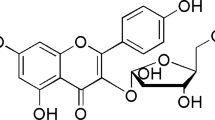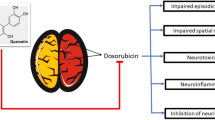Abstract
Purpose
In addition to peripheral neuronal dysfunction, conventional chemotherapy can be associated with other neurological treatment-limiting adverse effects, including cognitive dysfunction, memory impairment, and anxiety, which are referred to as “chemobrain”. This study aimed to investigate the effects of doxorubicin (DOX) and paclitaxel (PAC) on learning and memory in rats using radial arm water maze (RAWM) and investigated a potential beneficial effect of vitamin E (Vit. E).
Methods
Adult male rats were injected with four doses of 2 mg/kg/week DOX, or 2 mg/kg PAC every other day intraperitoneally. Vit. E was co-administered with these drugs in other groups to study its antioxidative effects. Using the RAWM, each rat was assessed for learning and memory performance through two sets of six trials separated by a 5-min rest period evaluating both short- and long-term effects on memory.
Results
There was no deficit in learning or long-term memory in both drug groups compared to control. However, rats in both drug groups made significantly more errors in all short-term memory trials. This effect was mitigated when Vit. E was co-administered with either drug. Moreover, PAC (but not DOX) induced hippocampal lipid peroxidation by increasing the levels of standard biomarker thiobarbituric acid reactive substances (TBARS). Interestingly, Vit. E prevented PAC-induced hippocampal oxidative stress. Furthermore, both DOX and PAC were correlated with reduction in Brain-Derived Neurotrophic Factor (BDNF) expression levels in the hippocampus, which was overcome by the co-administration of Vit. E.
Conclusion
There is a potential role of Vit. E in alleviating short-term memory impairment in rats exposed to chemotherapy, possibly by reducing hippocampal oxidative stress and neurodegeneration.




Similar content being viewed by others
Data availability
The data that support the findings of this study are not openly available due to logistic reasons. However, they will be available upon reasonable request. Data archiving is not mandated.
References
Colvin LA (2019) Chemotherapy-induced peripheral neuropathy: where are we now? Pain 160(Suppl 1):S1–S10
Selamat MH et al (2014) Chemobrain experienced by breast cancer survivors: a meta-ethnography study investigating research and care implications. PLoS ONE 9(9):e108002
Koppelmans V et al (2012) Neuropsychological performance in survivors of breast cancer more than 20 years after adjuvant chemotherapy. J Clin Oncol 30(10):1080–1086
Wefel JS et al (2004) The cognitive sequelae of standard-dose adjuvant chemotherapy in women with breast carcinoma: results of a prospective, randomized, longitudinal trial. Cancer 100(11):2292–2299
Sardi I et al (2013) Pharmacological modulation of blood-brain barrier increases permeability of doxorubicin into the rat brain. Am J Cancer Res 3(4):424–432
Ramalingayya GV et al (2017) Rutin protects against neuronal damage in vitro and ameliorates doxorubicin-induced memory deficits in vivo in Wistar rats. Drug Des Devel Ther 11:1011–1026
Duggett NA et al (2016) Oxidative stress in the development, maintenance and resolution of paclitaxel-induced painful neuropathy. Neuroscience 333:13–26
Kaplan SV et al (2016) Impaired brain dopamine and serotonin release and uptake in wistar rats following treatment with carboplatin. ACS Chem Neurosci 7(6):689–699
Sekeres MJ et al (2021) Chemotherapy-induced cognitive impairment and hippocampal neurogenesis: a review of physiological mechanisms and interventions. Int J Mol Sci 22:23
Jarrard LE (1993) On the role of the hippocampus in learning and memory in the rat. Behav Neural Biol 60(1):9–26
Tong Y et al (2020) Polydatin ameliorates chemotherapy-induced cognitive impairment (chemobrain) by inhibiting oxidative stress, inflammatory response, and apoptosis in rats. Biosci Biotechnol Biochem 84(6):1201–1210
Ali MA et al (2020) Caffeic acid phenethyl ester counteracts doxorubicin-induced chemobrain in Sprague-Dawley rats: emphasis on the modulation of oxidative stress and neuroinflammation. Neuropharmacology 181:108334
Park HS et al (2018) Physical exercise prevents cognitive impairment by enhancing hippocampal neuroplasticity and mitochondrial function in doxorubicin-induced chemobrain. Neuropharmacology 133:451–461
Sonoyama T et al (2020) Human BDNF/TrkB variants impair hippocampal synaptogenesis and associate with neurobehavioural abnormalities. Sci Rep 10(1):9028
Cauli O (2021) Oxidative stress and cognitive alterations induced by cancer chemotherapy drugs: a scoping review. Antioxidants (Basel) 10:7
Rizvi S et al (2014) The role of vitamin e in human health and some diseases. Sultan Qaboos Univ Med J 14(2):e157–e165
in guide for the care and use of laboratory animals. 2011: Washington (DC)
McElroy T et al (2020) Assessing the effects of redox modifier MnTnBuOE-2-PyP 5+ on cognition and hippocampal physiology following doxorubicin, cyclophosphamide, and paclitaxel treatment. Int J Mol Sci 21:5
Ahmed M, Alzoubi KH, Khabour OF (2020) Vitamin E prevents the cognitive impairments in post-traumatic stress disorder rat model: behavioral and molecular study. Psychopharmacology 237(2):599–607
Smith AE et al (2017) The chemotherapeutic agent paclitaxel selectively impairs learning while sparing source memory and spatial memory. Behav Brain Res 320:48–57
Alzoubi KH et al (2009) Adverse effect of combination of chronic psychosocial stress and high fat diet on hippocampus-dependent memory in rats. Behav Brain Res 204(1):117–123
Jiang ZG et al (2018) PAN-811 prevents chemotherapy-induced cognitive impairment and preserves neurogenesis in the hippocampus of adult rats. PLoS ONE 13(1):e0191866
Mani V et al (2022) Levetiracetam ameliorates doxorubicin-induced chemobrain by enhancing cholinergic transmission and reducing neuroinflammation using an experimental rat model and molecular docking study. Molecules 27:21
Panoz-Brown D et al (2017) The chemotherapeutic agent paclitaxel selectively impairs reversal learning while sparing prior learning, new learning and episodic memory. Neurobiol Learn Mem 144:259–270
Sung PS et al (2021) Memantine protects against paclitaxel-induced cognitive impairment through modulation of neurogenesis and inflammation in mice. Cancers (Basel) 13:16
Cardoso CV et al (2020) Chemobrain in rats: Behavioral, morphological, oxidative and inflammatory effects of doxorubicin administration. Behav Brain Res 378:112233
English JD, Sweatt JD (1997) A requirement for the mitogen-activated protein kinase cascade in hippocampal long term potentiation. J Biol Chem 272(31):19103–19106
Hetman M et al (1999) Neuroprotection by brain-derived neurotrophic factor is mediated by extracellular signal-regulated kinase and phosphatidylinositol 3-kinase. J Biol Chem 274(32):22569–22580
Bagnall-Moreau C et al (2019) Chemotherapy-induced cognitive impairment is associated with increased inflammation and oxidative damage in the hippocampus. Mol Neurobiol 56(10):7159–7172
Boyette-Davis JA, Fuchs PN (2009) Differential effects of paclitaxel treatment on cognitive functioning and mechanical sensitivity. Neurosci Lett 453(3):170–174
Gugliandolo A, Bramanti P, Mazzon E (2017) Role of vitamin E in the treatment of alzheimer’s disease: evidence from animal models. Int J Mol Sci 18:12
Parcheta M et al (2021) Recent developments in effective antioxidants: the structure and antioxidant properties. Materials (Basel) 14:8
Li Z et al (2018) Proinflammatory factors mediate paclitaxel-induced impairment of learning and memory. Mediators Inflamm 2018:3941840
Meshkini A, Yazdanparast R (2012) Involvement of oxidative stress in taxol-induced apoptosis in chronic myelogenous leukemia K562 cells. Exp Toxicol Pathol 64(4):357–365
Jablonska-Trypuc A et al (2018) Possible mechanisms of the prevention of doxorubicin toxicity by cichoric acid-antioxidant nutrient. Nutrients 10:1
Ohtsuka A et al (1998) Vitamin E reduces glucocorticoid-induced growth inhibition and lipid peroxidation in rats. J Nutr Sci Vitaminol (Tokyo) 44(2):237–247
Singh G et al (2010) Effect on antioxidant levels in patients of breast carcinoma during neoadjuvant chemotherapy and mastectomy. Malays J Med Sci 17(2):24–28
Bekinschtein P et al (2008) BDNF is essential to promote persistence of long-term memory storage. Proc Natl Acad Sci U S A 105(7):2711–2716
Du J et al (2021) Doxorubicin-induced cognitive impairment: the mechanistic insights. Front Oncol 11:673340
Olton DS, Papas BC (1979) Spatial memory and hippocampal function. Neuropsychologia 17(6):669–682
Ohno M, Yamamoto T, Watanabe S (1993) Blockade of hippocampal nicotinic receptors impairs working memory but not reference memory in rats. Pharmacol Biochem Behav 45(1):89–93
Diamond DM et al (1999) Exposing rats to a predator impairs spatial working memory in the radial arm water maze. Hippocampus 9(5):542–552
Baghcheghi Y et al (2018) The effects of vitamin E on brain derived neurotrophic factor, tissues oxidative damage and learning and memory of juvenile hypothyroid rats. Metab Brain Dis 33(3):713–724
Mahdinia R et al (2021) Vitamin E attenuates alterations in learning, memory and BDNF levels caused by perinatal ethanol exposure. Nutr Neurosci 24(10):747–761
Abd El-Fattah AA et al (1998) Vitamin E protects the brain against oxidative injury stimulated by excessive aluminum intake. Biochem Mol Biol Int 46(6):1175–1180
Acknowledgements
This work was supported by Deanship of Research in Jordan University of Science and Technology (grant #: 109/2021). Also, the authors would like to thank Khawla Al-Mhedat and Roaa Obiedat for their technical support.
Funding
This project was funded by the Deanship of Research, Jordan University of Science and Technology (Grant number: 109/2021).
Author information
Authors and Affiliations
Corresponding author
Ethics declarations
Conflict of interest
The authors declare no financial or non-financial interests that are directly or indirectly related to the work.
Additional information
Publisher's Note
Springer Nature remains neutral with regard to jurisdictional claims in published maps and institutional affiliations.
Rights and permissions
Springer Nature or its licensor (e.g. a society or other partner) holds exclusive rights to this article under a publishing agreement with the author(s) or other rightsholder(s); author self-archiving of the accepted manuscript version of this article is solely governed by the terms of such publishing agreement and applicable law.
About this article
Cite this article
Altarifi, A.A., Sawali, K., Alzoubi, K.H. et al. Effect of vitamin E on doxorubicin and paclitaxel-induced memory impairments in male rats. Cancer Chemother Pharmacol 93, 215–224 (2024). https://doi.org/10.1007/s00280-023-04602-y
Received:
Accepted:
Published:
Issue Date:
DOI: https://doi.org/10.1007/s00280-023-04602-y




